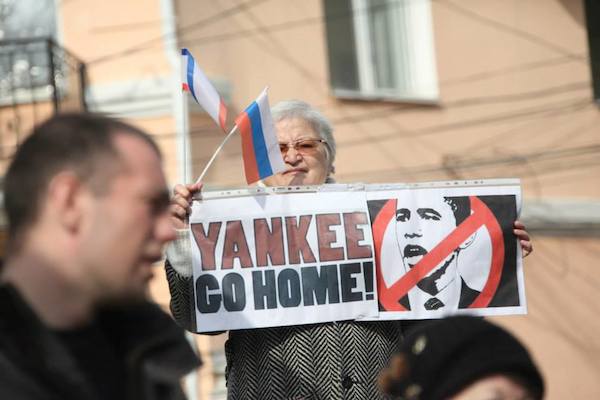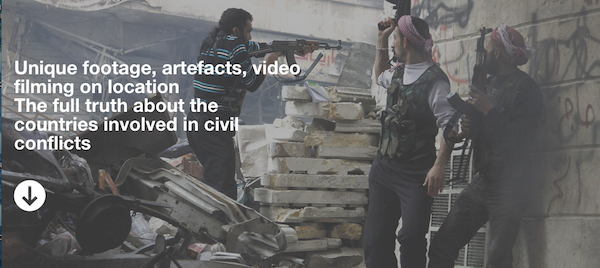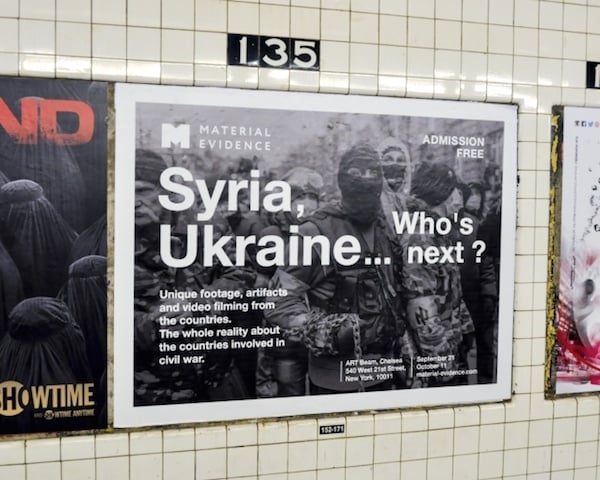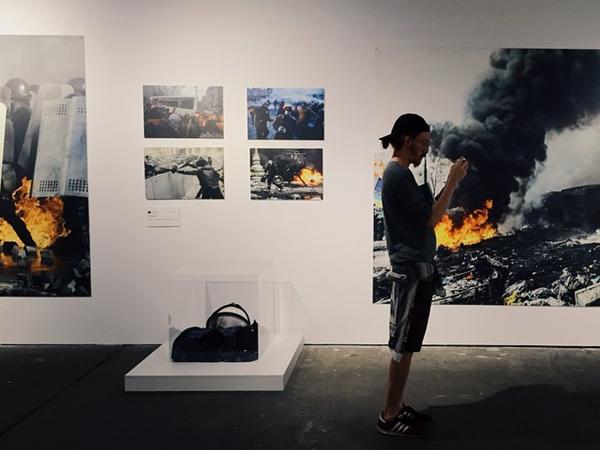Art & Exhibitions
Did Russia’s Internet Propaganda Agency Stage Neo-Nazi Attack on Chelsea Gallery?
The curator now says he doesn't want to be affiliated with the project.

The curator now says he doesn't want to be affiliated with the project.

Ben Davis


Screenshot from the “Material Witness” website
Adrian Chen’s blockbuster New York Times Magazine story this weekend about Russia’s government-run “troll farms”—teams of operatives paid to introduce industrial-strength levels of misinformation into the Russian internet and beyond—raises major questions about how governments wage information war in the Internet age. Perhaps one of the most head-spinning possibilities raised by the story concerns a troubling, heretofore unexplained attack on a Chelsea gallery show this past year.
On the morning of October 2, 2014, “Material Evidence. Syria. Ukraine,” a group photojournalism exhibition purporting to show the “whole reality about the countries involved in civil war,” on view at a rental space in the former EyeBeam location (540 West 21st Street), was vandalized by three mysterious attackers (see Ukrainian Photo Exhibition in Chelsea Vandalized).
According to Hyperallergic, one of the attackers is said to have pepper-sprayed the curator of the show, German-American photojournalist Benjamin Hiller, declaring, “You bring shame on the Ukrainian people.” Others distributed leaflets with Nazi imagery, and scrawled the word “LIE” next to one of the exhibition’s exhibits depicting “a member of a far-right group giving a fighting lesson to anti-Russian Ukrainians,” according to the New York Times’s report on the incident.
According to the Times‘s report, police never followed up on the incident because there were “no visible signs of injury.” The perpetrators were never heard from again.
The show was between tour stops in Berlin and Moscow. Footage of the Berlin outing, from the RT news network, gives the flavor of the exhibition’s mixture of artifacts of war and anonymous photojournalism:
Chen’s lengthy Times Magazine story focused on Russia’s cyber-propaganda division, known as the Internet Research Agency, originally organized to counter the social media-savvy of anti-Putin protesters in 2011. More recently, however, an elite section of the organization has focused on English-language trickery. Their efforts include elaborate hoaxes such as spreading word of a terrorist attack at a chemical plant in Louisiana and a fake police killing in Atlanta. Both incidents included not just scores of dummy Twitter users spreading viral misinformation, but fake YouTube clips depicting the sensational events.

Image from the Syria section of “Material Evidence,” posted to the show’s Facebook page
In the course of his report, Chen connects the Chelsea show to the Agency, tracing Twitter accounts promoting “Material Evidence” to previous attempted hoaxes, such as the above fake chemical explosion in Louisiana. He also reports that Hiller, who previously went to great lengths to defend the show’s objectivity, now says that he “does not want to be affiliated anymore with the project” due to its “nonjournalistic approach.” (artnet News was not immediately able to reach Hiller for further comment.)
Oddly, however, unmentioned in the Times Magazine essay is the attack on the gallery, an explosive news story at the time that probably did more to promote it than the 250 subway ads. The elaborate but strangely tone-deaf schemes documented in Chen’s story cast the strange events in Chelsea in a distinct new light.

Subway ad for “Material Witness” exhibition at ArtBeam
Reporting on the attack in its immediate aftermath, art reporter Mostafa Heddaya noted that questions had been raised as to whether it had even really taken place, as well as about the origins of the well-produced and well-advertised but supposedly grassroots photo show itself (an RT report identified its backer as a right-wing Russian paper, while Gawker relayed a story from one of the curators that it was funded by a “silent guy” who brought “a bag of cash and dropped it for them with no explanation”).
Eight months later, Chen’s story raises the question: Could the vandalism attack have been a media stunt set up by Russia’s misinformation specialists, designed to portray pro-Ukrainian activists as thugs in the U.S. media?

Installation view of “Material Evidence” at ArtBeam, New York City, 2014, posted to Material Witness Twitter account (@MatWitness)
This is speculation. But if the notion seems beyond the bounds of possibility, consider one of the more incredible turns in Adrian Chen’s article, which concludes with the author himself becoming the object of an elaborate media hoax. Clandestine footage of an interview Chen did with a source at a St. Petersburg cafe was recut so as to appear that he was consorting with a notorious neo-Nazi, then circulated in the Russian media—evidently an effort to pre-discredit his Times Magazine story on the Internet Research Agency.
“I thought the attack was pretty odd when I read about it,” Chen told artnet News yesterday when asked if he was aware of the attack on “Material Witness,” and how it might relate to his larger story, “and after what happened to me in Russia I wouldn’t be surprised if there was something more to it than it seems.”